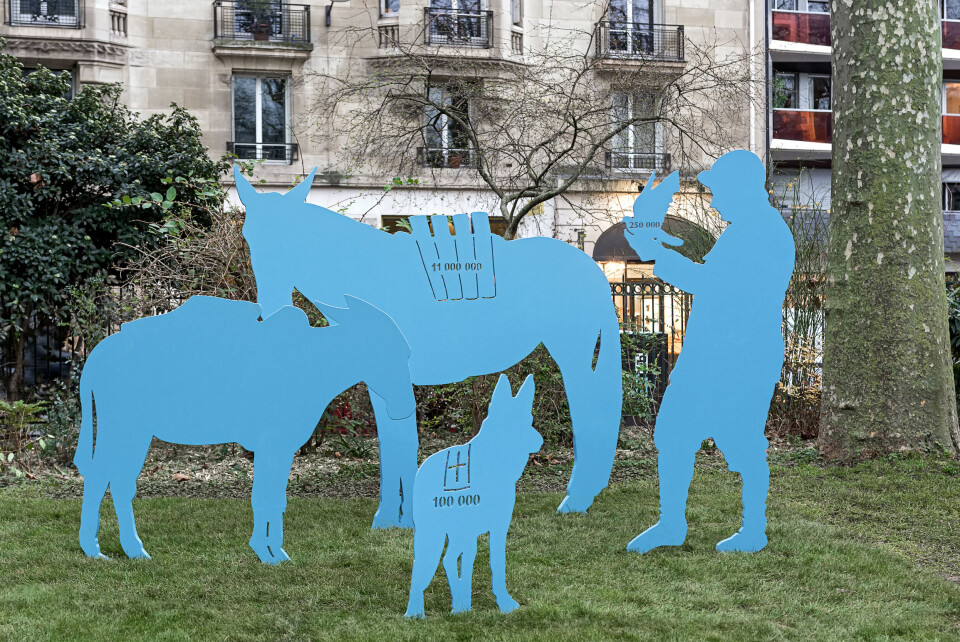-
Strikes and protests in January 2026 and how you may be affected
Doctors, rail staff, and farmers are all taking action
-
Good news as lower electricity bills confirmed in France
The change is not a ‘revolution’ but will give some purchasing power back, minister says
-
French ski resorts report excellent Christmas despite less snow than last year
Bookings are up and non-snow related activities are also on the rise
New war monument in Paris honours animals that died in service
The project was inspired by similar artworks in London

A monument to fallen animals during World War One has been officially unveiled in Paris.
The sculptural monument was revealed to visitors in an official ceremony in Square Boucicaut, a public park in the 7th arrondissement, on January 30.
The statues represent a dog, a donkey, a horse and a dove held by a soldier - painted in blue, the characteristic colour of French World War One soldiers (due to their uniforms). It was created by artist Gérard Collin-Thiébaut.
Three of the statues are embedded with a number, representing the casualties for each breed. World War One claimed 11 million horses, 100,000 dogs, and 250,000 doves, the carvings state.
There are no official historical records of the number of donkeys and mules used during the war, which explains why the donkey figure shows no number.
The unveiling is the culmination of a five-year long project led by Paris Animaux Zoopolis (PAZ), an association fighting for animal welfare.
“We wanted a monument of nationwide stature,” said Amandine Sanvisens, the co-founder of PAZ, to The Connexion.
“With this monument, we can no longer forget the history of the animals [involved in the conflict]. It provides access to a little-known aspect of French history,” she added.
PAZ took inspiration from the Animals in War Memorial in London, which includes a curved mural and animal statues, to commemorate the animals that have served and died in British military operations.
The monument adds to two commemorative plaques installed in the 11th and 19th district of Paris, which honour horses that were drafted during the war. Other plaques are soon expected to be laid in the 8th, 14th and 18th districts, said Ms Sanvisens.
Read also: Cat compensation case is 'turning point' for animal rights in France
Historical researches
The monument was first proposed in 2018 for the centenary of World War One. It was inspired by the book Bêtes des tranchées: Des vécus oubliés, written by Eric Baratay in 2013, which looked at the animal casualties of World War One.
PAZ combed through a considerable amount of documents to trace back some of the personal stories behind several Parisian animals drafted for the war.
The team found clippings from old newspapers that mentioned the story of Vitrier, a starving dog that was found on August 24, 1914 roaming the Boulevard Raspail after it had lost trace of its battalion.
“Dogs are sold as merchandise and often abandoned. Pigeons are gassed. These animals were with us during World War One [but] we consider them to be toys, attractions, resources, transportation means, in short…objects,” said Ms Sanvisens in her speech yesterday.
“This monument is an opportunity to question and rethink our relationship with animals,” she added.
Ms Sanvisens also commented that she was surprised that the project had not obtained faster and more unanimous support from Paris Mairie officials. She said that the support of Le Souvenir Français, an association fighting for war remembrance, had considerably facilitated the process instead.
“There were always two or three people against it,” she said. “[In contrast] projects around animal rights in the United Kingdom seem to be unanimous.”
However, initial reactions have not been unanimous in favour of the statues; some viewers - interviewed by Le Parisien - suggested hesitatingly that they “look a little bit like children’s drawings”.
Related articles
France’s army platoon of carrier pigeons is one of its kind in Europe
Tiny Normandy commune to celebrate crucial role in D-Day landings
























